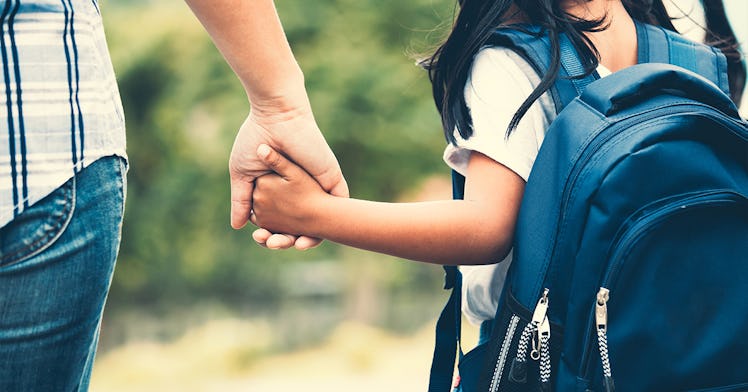Parents Want Schools To Reopen Just as Much as Trump — That’s the Problem
Trump is pushing for schools to reopen. Parents are desperate for a break.

Parents are tired. Parents need kids to go back to daycare. Many parents, out of economic necessity, already have sent their kids back to daycare. And now, with the Fall of 2020 looming, the big question remains: Will public schools re-open. Parents want them to, but should they?
On Tuesday alongside Education Secretary Betsy DeVos, President Trump demanded that all schools across the country fully reopen physically in the fall. Part of Trump’s argument to reopen schools — despite a whopping total of 60,000 new cases confirmed yesterday in the United States alone — was that the mental, social, psychological, and educational costs of keeping kids at home would be far more harmful than COVID-19 itself. Both the American Academy of Pediatrics and the Centers for Disease Control agree with this claim and have released public health guidelines on how to reopen schools in Fall 2020.
Trump’s calls to reopen schools will be met even by people who don’t like him, which if you look at polls, is most of us. The many millions of parents who have spent the past half of a year juggling parenting, managing remote schooling, and working full-time jobs. In order for things to go back to “normal,” or at least for an economy to begin chugging along again, kids need a place to go during the day. Parents can’t be made to, once again, do a dozen jobs at once. This is clearly not an issue that can be brushed away or ignored.
But. And it’s a big but. That doesn’t mean schools can re-open the way Trump wants them to.
Unlike the CDC and the AAP, the Trump administration provided no guidelines on how schools should reopen and no financial assistance to schools to reopen in accordance with public health guidelines. He did, however, threaten to cut funding to schools that wouldn’t open fully in the fall, and Education Secretary Betsy DeVos has said that all schools must be fully operational come September. Punishing schools for not opening is not the same as helping parents out. Let’s make that clear.
Trump also has not endorsed either the AAP or the CDC’s guidelines to reopen schools, instead, he’s openly deriding them on Twitter. The CDC released guidelines that called for increased hygiene, using masks in schools, and, if need be, doing a mixture of remote and in-school learning several days a week so that students are in schools at certain times and out of school so other students can be in school, in order to encourage appropriate physical distancing. The AAP released a statement at the end of June that strongly recommended that students be physically in schools as much as possible, calling for, among dozens of other things, physical distancing when possible between children and adults and adults, face mask adoption by students and adults, and guidelines for how to distance on buses and in cafeterias. Whether or not those guidelines can be followed is another question altogether.
The AAP and CDC releasing these guidelines support of an obvious reality: schools need to reopen for kids, and for parents, and for the economy. The same is true of childcare across the country. Without them, parents, most of whom work full-time jobs, will be stuck. But doing so safely will not be as easy as deciding that they should be open and opening them at full capacity. And it doesn’t appear, per Trump’s statements and the statements of the administration, that there are any plans to reopen alongside public health guidelines.
These plans to hastily reopen schools also stand in the face of the fact that we have a massive school nurse shortage. In the vast majority of American schools, there isn’t a full-time nurse, and in many schools, there are no nurses at all. Funding cuts in schools have led to cramped conditions, overcrowded classrooms, and offices as small as closets. Schools reopening might not be associated with a massive rate in climbing cases, but as cases continue to skyrocket in the United States, a national reckoning with the height of the first wave of the pandemic is no Norway, no Germany, no Denmark.
These series of realities have led to school districts making unpopular decisions with both parents and the Trump administration. New York City Public Schools, one of the largest school districts in the nation, recently committed to doing staggered schedules where only a certain number of students go in a few days a week, and do the rest of the week learning remotely. In Austin, Texas, where cases are exploding and school begins in six weeks, the district has gone forward with plans to either have students do 100% in-person learning or 100% remote learning, leaving parents with an impossible choice to make. Districts across the country will make similar decisions. Most likely, none of them will go over well.
None of these choices will help parents feel better or help them manage their lives more safely. The pandemic still rages on, parents still need to work, and online learning is not a replacement for in-school education. After all, having a kid in school only two days a week won’t solve the problem of being able to go to work, leaving parents still hung out to dry and struggling to make it work.
Schools will reopen across the country, assuming those schools think it’s safe to do so. Parents will send their kids back — assuming they are comfortable with what the school is proposing. These decisions will be made locally. And nothing Trump says or does can change that.